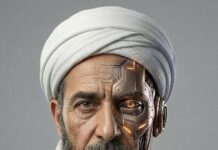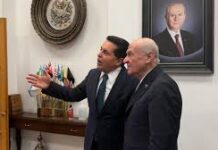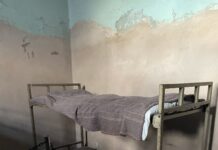In my previous essay, I dissected the first paragraph of the NYT editorial staff’s August 2014 reaction to the Turkish presidential election. Towards the end, I came to the gist of the matter — that the Turkish political system has never featured democratic checks and balances of the sort that U.S. citizens are familiar with. Furthermore, this is not the AKP’s work. It is due to the peculiar systemic features which, established under Mustafa Kemal’s auspices in the 1920s and 30s, have continued to define Turkish political life at least until 2007.
Explaining how Kemalism became the entrenched attitude of the Turkish military and state institutions could involve covering the entire history of the Turkish Republic. Here, instead, is an all-too-brief summary: From 1925 to 1950, the Turkish state and the political party founded by Mustafa Kemal, the CHP (Cumhuriyet Halk Partisi, or the Republican People’s Party), were inseparable from each other. The party was the state and the state was the party. The structure of the Turkish political system was steeply vertical. The executive comprised the President, the Prime Minister, and the Cabinet, all of which stemmed directly from the legislative branch, that is to say the Grand National Assembly. The judiciary, meanwhile, was never a genuinely independent branch but another appendage of the party-state expected to provide legal cover and ideological guardianship for the political system.
Law and the judiciary against civilian politics and parliament
The essentials of this situation never really changed despite the emergence of a multi-party system in 1946-1950. Indeed, sometimes things went the other way. After the 27 May 1960 coup, several new bodies intended to reinforce the de facto establishment were added to state organization. This included a senate meant to constrain any popular lower house majority, as well as a quota of fifteen presidentially appointed senators to further entrench Atatürkist conservatism in that senate. Most relevant to the judiciary was the new Constitutional Court empowered to review the constitutionality of all parliamentary legislation. This introduced a possibility of intervention in law-making by overriding the parliamentary majority on grounds of unconstitutionality (real or imagined), and amounted to yet another route by which the military could keep tabs on civilian (= elected) politicians. This also became part and parcel of the teaching of law. The two most important Turkish law schools (at İstanbul and Ankara University) had always been strongholds of Kemalist ideology, indoctrinating generations of judges, prosecutors and lawyers in the notion that they should always have the interests of the state at heart. To this they now added the proposition that electoral politics was intrinsically suspect, that politicians were always out to transgress against the Constitution (read: the state), and that it was the duty of the judiciary to rein them in. To maintain the prerogatives of a non-elected deep state establishment — this became the grotesquely distorted Turkish version of the separation of powers, or of democratic checks and balances. From the 1950s to the end of the century, jockeying for influence and financial resources in Turkish state institutions went on unabated. Corruption was always there and transparency was always absent.
As another constant, the Turkish military kept acting as the ultimate overseer of the whole system. In 1946 electoral fraud was experienced (and massively, too) for the first and last time in a multi-party context as the pro-CHP Atatürkist bureaucracy sought to keep the new Democrat Party out of power. The reaction was such that since 1950, Turkish elections have been free, open, and transparent. At the same time, the Turkish military, whether through clusters of lower-ranked officers or in regular chain of command, have always been waiting in the wings to see if civilian politicians appearing to deviate too far from Kemalist ideals might give them cause to step in. (1) As a matter of fact, they did actually intervene in 1960, 1971, 1980, and 1997, with each such military takeover (or semi-takeover) witnessing additional incrustations of guardianship. Thus after the 1960 coup d’état, a new state organ was formed called the National Security Committee (Milli Güvenlik Kurulu). I have always assumed that the nominal similarity to the U.S. National Security Council was intentional. However, unlike its American prototype, the Turkish version was not designed to improve communication between the various branches of government. Instead, the Turkish version was a venue for the top brass to participate in making policy — the direct face-to-face forum (2) in which they could turn the screws on the politicians.
The 2007 crisis over retaining control of Çankaya Hill
That brings us to 2007-2008. In late 2006 it was clear that the AKP-dominated parliament would be nominating the prominent AKP politician Abdullah Gül as their candidate to replace Ahmet Necdet Sezer in the 2007 presidential election. A political crisis ensued. At the time, Article 102 of the 1982 Constitution (as made by the 12th September 1980 junta) decreed that in the first two rounds of balloting in parliament, a two-thirds majority of 367 was needed to elect a new president, but that subsequently, a simple majority of 276 would suffice. Then on 26 December 2006, Sabih Kanadoğlu, a former chief procurator of the Republic, wrote an article where he argued that this magic figure of 367 also meant those MPs who had to be present in order for the voting to be valid. That is to say, there had to be a two-thirds majority for parliament to meet, and not just for electing a new president. Pushing textual interpretation to illogical limits, and also without any practical precedent whatsoever, this bizarre notion was clearly intended as a signal for all other parties to absent themselves so that with just 354 seats in the National assembly, the AKP would find it impossible to elect its own candidate. Preposterous as it was, the CHP under Deniz Baykal went along with it, so that on the first round, Abdullah Gül was “elected” with 357 out of a total of 361 votes. The CHP immediately took the case to the Constitutional Court, and the Turkish military threw in its own weight by releasing a midnight memorandum that threatened yet another coup. Three days later, the Constitutional Court concurred by accepting the two-third quorum argument thereby declaring the first-round vote null and void. All this reflected a crystal clear case of collaboration between the top judiciary, the military and the Kemalist party in minority opposition (the CHP) to block the workings of electoral democracy.
But more was to come. Uncowed, the AKP decided to take the matter to the people by calling for early elections. Simultaneously, it introduced Constitutional amendments clearly stipulating that (including the current round of presidential elections) it was sufficient for the Natioanl Assembly to meet with one-third present, whereas in the future the president would be elected by popular vote in two rounds. These amendments received 376 votes, i.e. more than a two-thirds majority. Nevertheless, they were vetoed by Ahmet Necdet Sezer, then serving as caretaker president, on the telling grounds that they would “create problems for the régime.” Parliament then insisted on the amendments with another huge vote of 370, and this time Sezer, unable to use a second veto, had no choice except to put the matter to the Constitutionally ordained referendum. Simultaneously he himself also took it to the Constitutional court, which however rejected his argument. The early elections held on 22nd July 2007 returned the AKP to power with 46.6 percent of the vote and 341 seats in parliament. At the same time, the MHP also broke the 10 percent barrier to rejoin parliament – and declared that it would not be boycotting the presidential election, circumventing a new “367” crisis and enabling Abdullah Gül to be elected Turkey’s eleventh president with 339 votes on the third round. Last but not least, the 21st October 2007 referendum resulted in a huge (68 percent) popular approval of the entire package of Constitutional amendments, and that truly signaled the end of an era.
What had happened was not only the loss of the presidency to the military-bureaucratic establishment. More drastically, in and through the 2007 crisis and its resolution, the military lost its ability to make the final decision in Turkish politics. Otherwise put, that was the key turning point when Turkey became a true democracy. Later changes to the current Turkish Constitution (which is still a holdover from the 1980 coup) made this a legal reality.
NOTES
(1) As General Kenan Evren said on 12 September 1980, “Silahlı Kuvvetler … Atatürk ilkelerine yeniden güç ve işlerlik kazandırmak, kendi kendini kontrol edemeyen demokrasiyi sağlam temeller üzerine oturtmak, kaybolan Devlet otoritesini yeniden tesis etmek için yönetime el koymak zorunda kalmıştır” (“The Armed Forces, … in order to impart fresh force and impact to Atatürk’s principles, in order to base a democracy that has become unable to correct itself on sound foundations, and in order to re-establish the lost authority of the State, have been forced to take over the government”).
(2) Literally so: the civilian politicians sat at a long rectangular table directly across from their military counterparts, and at the head of the table was the President, the symbolic descendent of Mustafa Kemal Atatürk. The seating arrangement was changed in August 2011 to convey a more democratic image.












